Finally I’m having a good time
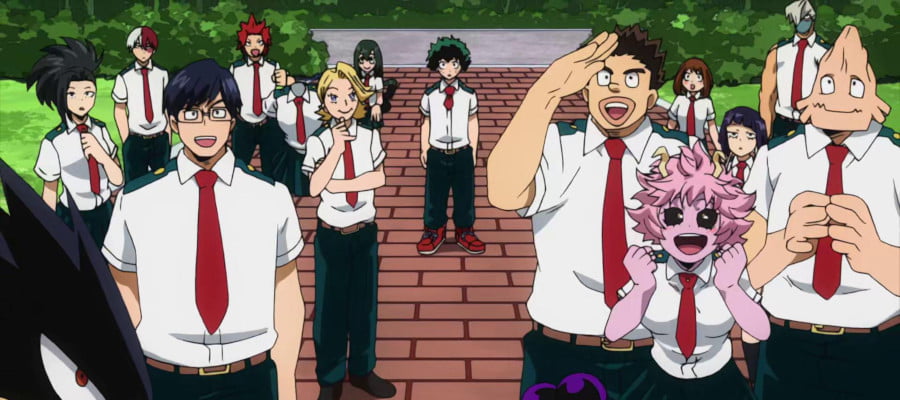
After two seasons of finding its feet underneath it, and also burning through a positively unnecessary amount of tournament head-to-head nonsense, My Hero Academia has finally set up a season that left me with an overall positive impression. It’s very clearly a show for little kids – recaps and previews can make up about six minutes of a 26 minute run-time, and wishing it did things differently is a bit of a fool’s errand.
What this season did have that I liked was three distinct story arcs, none of which were too long or dragged out their worst elements too long. I mean it’d be nice if they didn’t have the boring bits at all, but I understand that some people see the way that Deku and All Might both solve problems by Punching The Best Way as heroically important, and therefore, my desire for them to develop more than that is not happening.
This also seems to be the point where the story tries to grapple with having villains that are more than just a vaguely cryptic shape. I like the way the new villains are shaping up here, and I especially like the way they’re used sparingly.
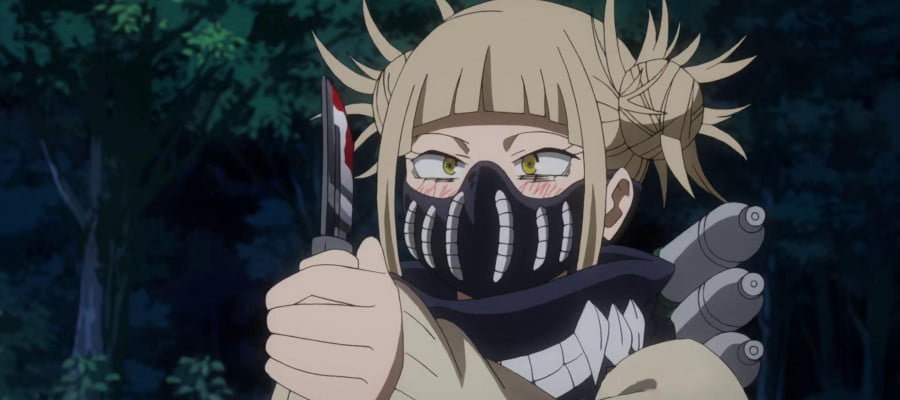
First up we have the woodland training arc. It’s got a good setup, something the students want to do, and where the nature of the experience keeps students spread out, gives them a lot of stuff to do and lots of different ways to express who they are. Then you throw into that training experience, which is largely fun stuff that looks at the characters and asks ‘hey, how do your powers work and how do we make them better,’ like the quirks as lived components of a character’s experience. That’s good! Then to complicate that, instead of a tournament of the characters slapfighting with one another, the story introduces some real tension in the form of an attack from villains who have a specific plan.
This is good! It’s remote, so you can have an excuse for where the support structure is, it’s reasonably safe so there’s no need for a primary focus on collateral damage and it’s big enough that people can get lost and have chunked up conflicts that give them opportunities to express themselves in a lot of different ways. The story introduces a bunch of villains ranging from the fun and interesting (Toga, Twice, Mr Compress, Magne) to the miscellaneous (everyone else). With a lot of villains spread over a lot of territory coralling a lot of students, you have a ready made opportunity for lots of different characters to try and deal with different things in different ways. This can lead to some great fights where characters work together in interesting ways – I really liked Tetsutetsu and Kendo fighting Mustard, for example, and the use of Twice to extend the reach of villains was also great!
Tell you what though this arc really reminded me that I will put up with a lot of bullshit from a character in this world if they look like they’re having a good time. This did mean that the stuff that the story thinks of as important – Midoriya vs Muscular for example – was an absolute dead end for me. It’s anti-interest; it’s not like Deku’s going to die, and he’s also not going to do anything interesting. The fight is about a dude who wins vs a dude who wins, and the dude wins until suddenly the other dude wins. The hopeful outline of it – a story where Deku learns to rescue someone, fight for them, and to think of the world around him in a fight? It’s completely dismissed in favour of but what if we punch each other really hard.
This artist has a vision of combat violence that is embarrassingly basic.
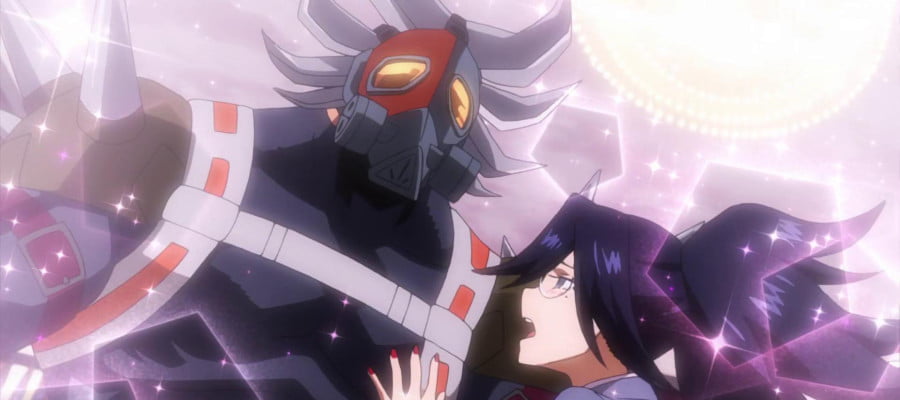
The next story arc teeters on the edge of more of that frustrating ‘I can see a better way to do this’ narrative. On the one hand, a big slugfest between two really powerful dudes who hate each other while the story flicks out to flashbacks is extremely standard, and this doesn’t elevate the form at all. Seeing some of All Might’s backstory is interesting, but it’s also done to introduce a fridged lady mentor figure, which feels a bit basic at this point? And that’s kind of everything that there is going on in this chunk of the story; it’s potential for more, but it’s very basic.
It obviously has to set up the loss of All Might; the departure of the powerhouse version of the character from the story is obviously important, and that’s a good thing to do here, and spending all the last measure of his strength on a great villain is a good way to do it. But there are … weird elements to it.
First of all, the villain has this big reserve of interesting powers, just based on what we’ve seen, and most of what he does is just ‘hit All Might harder.’ Now, I have no doubt that this is meant to chain into a later plot where this is all part of his plan, but be honest: if he beat All Might to death in this fight, it’s probably a big opportunity for a major supervilain. The idea that he fought in this really basic way for some greater, later plot is just kicking the can down the road, because if he could have killed All Might and didn’t, then whatever plan he has has to be incredibly and stupidly elaborate.
Bleh!
On the other hand, the story shows the importance of protecting and rescuing people. Deku’s ability to understand how people think, including Bakugo, is instrumental to getting them all safe and clear. Mount Lady even has an excellent moment that serves to cut the tension and give a laugh. The villains get away in an interesting (though creepy!) way. In the aftermath, All Might makes a point of now trying to make things better for Deku by teaching him things, and that’s super important too!
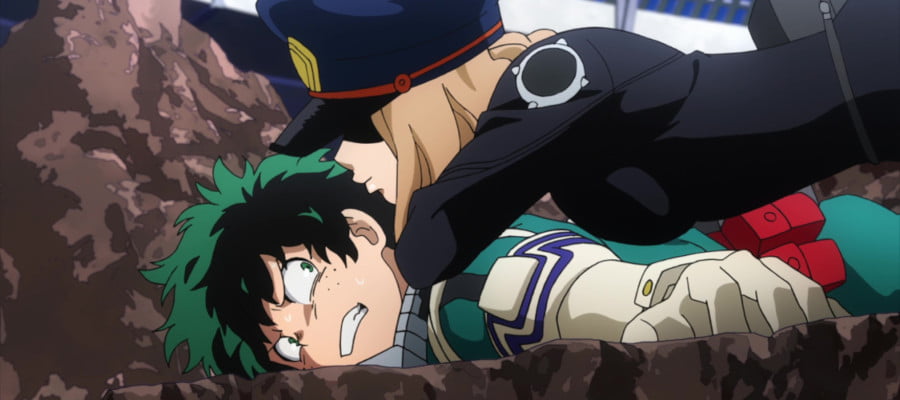
Then again, do you remember how I said that the sign of a shonen is how quickly it broke out a tournament arc? Well, it feels like the license exam is another tournament arc. It’s especially annoying because it’s not a good example of what a license is meant to do – you want to make sure that people are registered for the task, contactable, and have accepted public responsibility, it seems that this filtering system designed to only permit a hundred at a time would just encourage more vigilantism.
Still, despite this, there’s still two things I really enjoyed here. Another round of interesting bit-part characters get introduced – I like Tatami for example – and we’re once again introduced to an antagonist who is, at the very least, having a good bloody time. I thought Camie was interesting, but the way her character seemed to be just a repeat of Toga’s ‘hey, what about blood?’ personality seemed like a failure on the story’s part. But then that paid out, and that was pretty cool.
I also liked that a whole chunk of this license program is dedicated to explaining and demonstrating that heroes need to know how to rescue people. I’d have liked it more if this showed up beforehand, where, like, teachers might be involved, to make sure the students are prepared for this conversation, but that’s running the risk of presenting this hero high school story as featuring some high school. I have already accepted that this story just isn’t about that – it’s an ordinary superpowered shounen anime that sometimes remembers that superheroes are a genre with their own language and storytelling ideas.
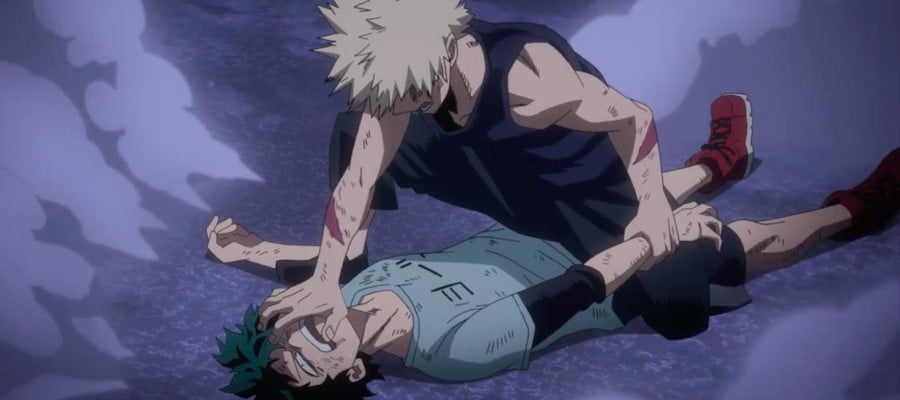
This season also introduces us to a pair of trans characters, in Tiger and Magne. It’s an interesting thing because Magne is a trans woman who somehow manages to skirt a lot of tropes that I’m used to seeing with that kind of character; oh, sure, she’s not presented as attractive or desireable, and her place in the world is a villain in an underclass, but it does this without bringing up the normal things that make me go ‘oh, god, no.’ There’s a whole conversation about her, about the way that trans women who don’t pass get treated as a different category to trans people who do pass, and the whole narrative around passing privilege (and when it’s withdrawn) is a complicated, interesting topic that is well above my pay grade.
Mostly, you can tell My Hero Academia thinks of Magne as a woman because it can’t think of anything to do with her.
Tiger is a much more neutral, natural zero-point though. He’s a big buff trans dude with a shapeshifting power that lets him look how he wants and he’s part of a successful hero group that lets him take care of other elements that he may want dealt with. Basically, I suspect he got top surgery but can use his power to do anything, so I don’t know what the difference is meant to be. Still, we have it confirmed that he did go ‘to Thailand’ for that, and that’s…
Yeah, that’s one of those things that sounds like a punchline.
I am a little tired by the way that Deku’s primary power is to eat shit with regularity, but he used it to good ends in the Bakugo fight. That fight presented a great kind of emotional payoff but still without an explanation. I don’t get it, I don’t get why Bakugo’s ego is so fragile and brittle. I don’t know how someone who has been praised non-stop and has superpowers and all that can still have such an inferiority complex unless there’s something about himself that he’s hiding, that doesn’t reconcile with the rest of who he is. Maybe like if he was trans or gay, that’d make sense.
I thought for a few days there that Muscle might be Bakugo’s real dad, and that might be the tension in his family that gave him this masculine fragility, but nope, it seems that Bakugo’s just a turd. Still, we got a moment of him getting a reassuring hug from All Might, and it being the limits of what he could handle, and that’s pretty good.
There are also some great episodes of the characters just messing around! That’s great! That’s stuff that gives characters room to express themselves and show more dimensions to how they work as characters. Great stuff there. Overall, I think this is a good season to start with because it explains most of everything (most characters get explained too many times honestly) and you don’t miss much of anything in the previous stories.